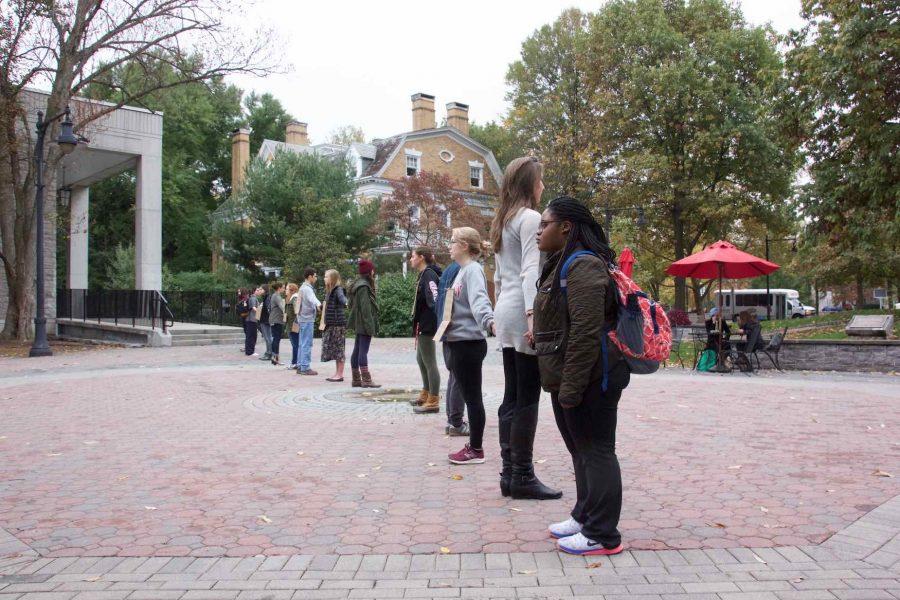Dickinson Students Protest Dakota Pipeline
Photo Courtesy Madison Underhill ’19
Students on Britton during the silent protest.
On Thursday, Oct. 27 students entering the HUB spoke softly as they navigated around a line of silent protesters stretching across Britton Plaza, linking hands across the Dickinson seal in protest of the Dakota Access pipeline.
The 14 demonstrators, made up mostly of members of the environmental activism club, Tree Club, stood in protest of the Dakota Access pipeline.
“The point was to create a human pipeline across Britton Plaza to educate the Dickinson community about the Dakota access pipeline,” said Rachael Moore ’18, a member of the Tree Club who participated in the protest.
The group wanted to “Inconvenience [Dickinsonians] the way the pipeline would inconvenience the Sioux people,” said Rachel Gross ’18, another participant in the protest.
The Dakota Access Pipeline is a $3.7 billion project developed by private limited liability company (LLC) Dakota Access, a subsidiary of Energy Transfer Crude Oil Company, LLC, according to daplpipeline-facts.com. The project, which, upon completion, would transport up to 570,000 barrels daily of oil from North Dakota to Illinois, was approved by the State of North Dakota and the United States Army Corps of Engineers, according to time.com.
Most recently, the pipeline has graced the front pages of the news for being a point of contention between the Standing Rock Sioux Native American tribe in North and South Dakota and the police force there. The pipeline would run under the Missouri River, which is the main source of water for the tribe of 10,000. Protesters from around the U.S. have flocked to North Dakota to join the protest, says time.com.
“Clean water is essential to life. The basic human rights of the Sioux people are being put at risk, therefore it is important to support their protest and amplify their voices,” said Julia Mercer ’18, just one of a growing national body of support for the Sioux.
Recent clashes between the police and protesters in North Dakota has prompted supporters of the protesters to check-in on Facebook to Standing Rock in “hopes of confusing law enforcement officials they believe are trying to track protesters who are actually at the reservation,” according the New York Times. Dickinson students like Mercer have been participating in the movement.
“Checking into Standing Rock is not only an act of solidarity but also a means of assistance as it helps protect those at Standing Rock from police brutality and targeting,” said Mercer.
The Tree Club’s protesters hope their display of solidarity for the Sioux would have a lasting effect on the Dickinson community. “Even though what we did was only ten minutes,” said Nastia Khlopina ’18, “I hope people are still noticing what we left in the HUB,” referencing the signs of cardboard the protestors hung around their necks. The signs sported various messages like “stand with standing rock, defend their land,” and “pipes leak.”
Members of the Tree Club have protested pipelines not only in North Dakota, but locally – last weekend some members of the club attended a protest organized by Lancaster Against Pipelines protesting the construction of the Atlantic Sunrise Pipelines. “Pipelines have kind of been our non-official theme of the semester,” says Moore.
“Things like this should be talked about all the time, not just when it’s a hot topic in the news,” she said.
Gross says she was pleased with the outcome of the demonstration. “People who were walking by stooped and looked, and read, and seemed engaged,” she said.
Khlopina says she was happy with the result of the event given the numbers, but wished there were more participants. “If I were other people, I would join the line. The reaction I would like to see is more people joining the line, and joining hands.”
The protesters hope to see increased discussion of the Dakota Access Pipeline on campus, as “I don’t think Dickinson talks enough about environmental injustices in general,” said Moore.
“It’s really not about us,” concluded Gross. “That’s something that we wanted to make known. It’s about the people who are being affected. And we want to shine the spotlight on the issues that are facing their communities.”






